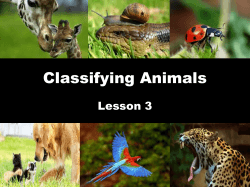
File
Name: ________________________________ Date: __________________ Animal Quiz #2: Endothermic and Ectothermic Organisms 1) What is the main difference between vertebrates and invertebrates? a. Vertebrates do not have backbones b. Invertebrates can fly c. There are more vertebrates than invertebrates d. Invertebrates lack backbones 2) Stinging tentacles and a central opening where food and waste both pass are characteristics of which invertebrate group? a. Arthropods c. Cnidarians b. Mollusks d. Worms 3) Sea Stars fall under which category of invertebrates? a. Echinoderms c. Mollusks b. Arthropods d. Cnidarians 4) Which of the following is NOT an example of an arthropod? a. Insects c. Cephalopods b. Crustaceans d. Arachnids 5) Worms have which of the following? a. Legs c. Shells b. Porous bodies d. Simple organs 6) ALL mollusks have: a. Soft bodies c. Tentacles b. Shells d. Antennae 7) Which of the following is not one of the MAJOR groups of invertebrates: a. Mollusks c. Crustaceans b. Sponges d. Arthropods 8) There is a group of vertebrates that spend the beginning of their life in water before they adapt to live on land. However, they must live in moist environments. What are these vertebrates? a. Reptiles c. Birds b. Amphibians d. Fish 9) All birds have: a. Wings c. Feet b. Beaks d. All of the above 10) Which of the following is NOT an example of a mammal: a. Shark c. Cat b. Whale d. Human 11) In what way are fish and reptiles similar? a. Both lay eggs on land c. Both are endothermic b. Both breathe through lungs d. Both are ectothermic 12) Endothermic means that an animal’s temperature: a. Changes with mood c. Changes with environment b. Remains relatively constant d. Changes depending on the season 13) Which of the following animals is ectothermic: a. King cobra c. Bald eagle b. Orangutan (ape) d. Tiger 14) Which of the following is true about endothermic animals: a. They can’t sweat c. They MUST change locations to cool down b. They have to eat more d. They become slow and sluggish in the cold 15) Ectothermic is also known as: a. Cold-blooded c. Hibernation b. Warm-blooded d. Invertebrate 16) Which of the following animals is NOT ectothermic: a. Fish c. Birds b. Reptiles d. Amphibians 17) Explain how an ectothermic animal might raise its body temperature: ______________________________________________________________________________ ______________________________________________________________________________ 18) Why might an exoskeleton be dangerous for an animal? ______________________________________________________________________________ ______________________________________________________________________________ 19) Which organisms are better adapted to live in the cold: Endothermic or ectothermic? Why? ______________________________________________________________________________ ______________________________________________________________________________ 20) Draw how an ectothermic animal might raise its body temperature: 21) Draw the process in which sponges get food: 22) Create your own animal in the space below. Draw and label its structures for movement, defense, and obtaining resources.
© Copyright 2025










